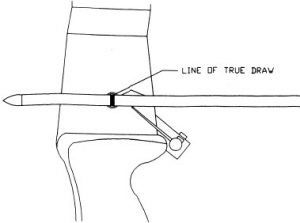The most important decision, by far, is what draw length you need to buy when looking at a new bow. Without the proper knowledge and some expert advice, the novice — and even some experienced archers — have made disastrous mistakes in this area.

True draw length can be measured by marking the arrow at the plunger hole.
The first major consideration for any archer is the make of compound bow you would like to shoot but, but the most important decision, by far, is what draw length you need to buy. Without the proper knowledge and some expert advice, the novice — and even some experienced archers — have made disastrous mistakes in this area. Knowing your true draw length is as important to your shooting success as knowing your shoe size is to your success at work. When the shoe doesn’t fit correctly, you feel miserable and perform poorly until you change it.
Same with an improperly fitted bow.

Finger style of shooting (left) requires use of a tab or glove. Release style of shooting (right) requires a mechanical release which is hooked to the bow string.
The most accurate method of measuring true draw length is to draw the bow of a friend who is about the same arm length as you. You must consider whether or not you plan to shoot the same style as your friend, i.e., with a release aid or fingers only. Release aids generally act as an extension to your fingers and cause the string to be drawn less distance than when drawn using a finger tab. This difference can be as much as two inches.

Your anchor must be comfortable and consistent no matter whether you shoot with fingers or release or where or how you anchor.
With this in mind, draw the bow in the style you plan to use and try to get comfortable with an anchor. This may take some experimenting if you are a beginning archer. A local dealer or an experienced archer can help at this time.
After you have drawn the bow several times and feel somewhat comfortable, draw again with an arrow in the bow. When you reach the anchor that seems comfortable, have someone mark the arrow adjacent to the rest mounting hole in the handle riser. This mark should be directly above the grip where your hand touches the deepest part of the handle. The distance from this mark to the recess in the nock is your true draw length. It is a measure of your body size for the purpose of drawing a compound bow.
BEWARE! Most bow manufacturers do not advertise or take orders using true draw measurements. Instead, they use a traditional draw length which is slightly longer than true draw. The difference is the difference from the plunger hole to the back of the handle riser. This adds about 1-3/4 inches to the true draw measurement. This gives us the following relationship:
Traditional Draw = True Draw + 1-3/4 inches

True Draw Length is the distance from the plunger hole or grip area to where the nock meets the string.

True Draw length can be measured when when the bow is at full draw.

Traditional draw length is measured from the side of the bow opposite the shooter.
Please keep in mind that your arrow length must be longer than your true draw length so the arrow point extends beyond your arrow rest. How much longer depends upon you and your purpose. If you intend to shoot broadheads, then your arrow length must be longer than the traditional draw length of the bow so the broadhead is not drawn into the handle riser or your fingers. The tournament arrow must extend only past the rest at full draw.
 TUNING YOUR COMPOUND BOW- Invaluable Tuning & Shooting Tips
TUNING YOUR COMPOUND BOW- Invaluable Tuning & Shooting Tips
by Larry Wise
International Archery
Champion & Archery Coach
If you shoot a compound bow, this book belongs in your tackle box! It is a practical, easy-to-follow, well-illustrated guide on high performance tuning for target shooting, field shooting, and bowhunting – all cams, all compounds. You can tune to your needs.
Information in the fifth edition of this archery classic includes chapters on asymmetrical (hybrid) cams, and a big chapter on 3-D tuning & shooting for bowhunting. These two chapters are extremely valuable to all compound bow shooters, but especially to bowhunters.
There’s other updated material on all cam styles, plus information-packed chapters on the wheel and cam (single & super) tuning, understanding force-draw curves, understanding stored and kinetic energy, Fast Flite string/cable system, compound bow power stroke, wheel functions and tillering, finding and shooting from the bottom of the valley, arrow rest selection and adjusting draw weight, checking fletch clearance and arrow flight, shoot testing, building and repairing carbon arrows, building, serving and repairing cables and bowstrings.
Plus detailed bowhunting practice and shooting tips.
The book is paperback, 5-1/2” x 8-1/2”, 152 pages. It can be ordered here on this website.

